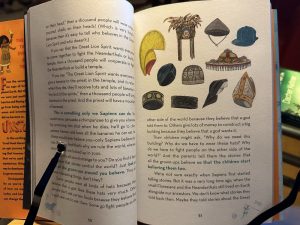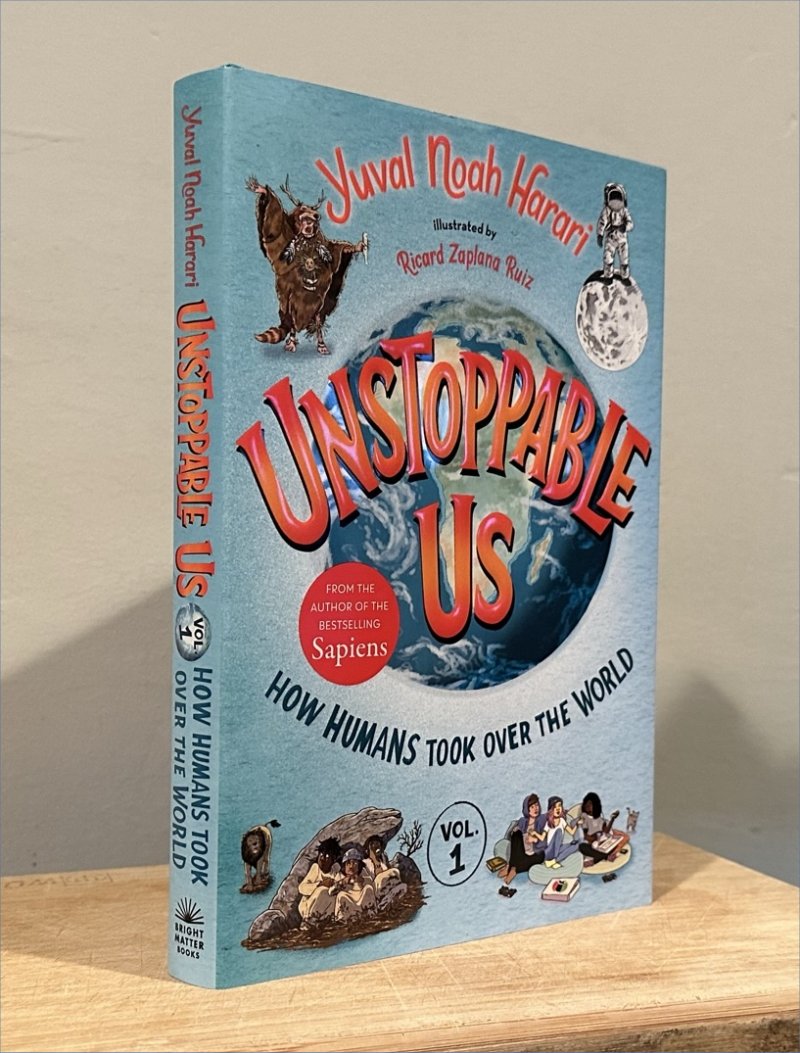Here’s a book I read near the end of last year that, like the Dawkins book recently reviewed, is a book directed at young people. Like the Dawkins, it’s heavily illustrated; unlike that, Harari’s book is essentially a rewrite of a book he has already written, his popular and bestselling SAPIENS from 2015 (my review here), aimed at younger readers. Apparently the first of several books. This one is subtitled “Vol. 1: How Humans Took Over the World.”
Subtitled: “Vol. 1: How Humans Took Over the World.” (Bright Matter Books, an imprint of Random House Children’s Books, a division of Penguin Random House; October 2022. xv + 189pp. With copious illustrations by Ricard Zaplana Ruiz.)
And so having read SAPIENS fairly closely, why did I read this? Because I was curious which of Harari’s striking takes on the history of humanity — things like his notion of “imagined orders”, i.e. narratives or shared myths, like money and in particular religion — would survive intact, or somehow be watered-down. And because it looked like a fun fast read.
The answer to my question is yes, those ideas survive intact, to a degree that I would not be surprised if some conservative-type parents, already so eager to ban books that don’t conform to their bronze age worldview, don’t try to prevent their kids from reading this one too.
Another reason for reading it was to see how far Harari could boil down the main points of his history, and to see exactly which points those would be. It’s one thing to read an author’s book and extract what you think are his main topics; it’s another to see how the author himself extracts his main topics. The answer to that is indicated by the topics of the four numbered chapters. I’ll arrange my summary and [[ comments ]] under those headings.
Ch1, Humans are animals.
- We used to be wild, just like all the other animals. [[ This is a basic idea spelled out here, perhaps considering the younger audience, that was taken for granted in SAPIENS. ]] Then came rocks, tools, fire. [[ Harari doesn’t mention this, but the idea that humans were once naked animals is consistent with our having evolved in Africa; humans could not have evolved in most of the places we now live in, given climates. ]]
- There were once different kinds of humans. They drifted apart via evolution, and spread around the globe. Small changes accumulate over time, unnoticed – this is one of the big laws of life, Harari states, p17t [[ another example of spelling things out very clearly for the younger readers ]]. All people now are the ‘Sapiens’ branch of humans. About 50,000 years ago Sapiens branched out from Africa and killed the other branches of humans, though we interbred with the Neanderthals and some of their DNA survives in us.
Ch2, The Sapiens’ Superpower
- The superpower is the ability of Sapiens to cooperate in very large numbers. [[ As mentioned before, this is a revision in anthropological thinking from 50 or 60 years ago, when the use of tools was considered the key development in humanity’s development – a thesis illustrated in the opening chapter of 2001: A Space Odyssey. ]]
- Cooperation is what has made humans powerful. And we learned to cooperate via our ability to think up stuff that isn’t really there, to tell imaginary stories, about spirits in the sky, what happens after we die, the rules of games, the idea of corporations, of money, of religious rituals. As long as everyone agrees about these stories, society works. Yet history advances sometimes by realizing these stories are nonsense, and moving past them [[ this aligns with Shermer’s point that moral errors arise from incorrect understandings of reality; I’ll get to that in THE MORAL ARC. ]] People can change the stories they believe (example of the divine right of king and the French revolution). Other animals use tools, but no other animals believe in stories. Many examples throughout this chapter.

- [[ Here the author and illustrator implicate religion as an imaginary story, via an illustration like this one above, though without identifying any current religion as such a story, in the text. So perhaps they do soften the point a tad. ]]
Ch3, How Our Ancestors Lived
- We’ve deduced much, but not everything, about how our ancestors lived, and their evolved behaviors still influence our own. Monsters under the bed; why things bad for us taste so good.
- We find evidence in caves, like paintings, but that doesn’t mean our ancestors lived in caves. Any more than what we call the “Stone Age” meant that people then made everything of stone. We don’t know what kind of social arrangements our ancestors had. (Many examples of other than standard mother/father/children family groups.) Compare situations today, and the variety of social practices of our various ape cousins: gibbons, gorillas, orangutans, chimps, bonobos.
- We know about tribe size, how large tribes would split into smaller ones, how everyone in a tribe would become expert about their environment, always learning. They worked far less than many people do today. But if you think the Stone Age was the best time ever, consider their accidents, diseases, living in the weather.
- And Stone Age adults believed that trees and animals could talk, that ghosts and spirits existed; they were animists. We know this by studying modern tribes in remote areas.
- [[ I don’t remember this much detail about this subject in SAPIENS; perhaps I misremember, or perhaps this is yet another subject especially suited for young reader. ]]
Ch4, Where Did All the Animals Go?
- And we know that over the past 50,000 years, as humans have expanded to all parts of the globe, they have killed off the big animals, especially recently in Australia and the Americas. Species like mammoths, mastodons, huge beavers, megatherium, all became extinct. It took only a few thousand years to settle all of North and South America. Mammoths lived until just 4000 years ago. Our ancestors weren’t cruel, exactly; they just didn’t know what they were doing. Small changes over time, again. Now, elephants could go the same way, unless humans are careful, and blue whales.
- Harari finishes by asking his readers to take responsibility for the future. We know what we are doing, and we can take responsibility, e.g. for the blue whales. We are the most dangerous animal in the world. How we learned all the things we have today, cities and cars, is another story – that’s for the next book.
There’s also a graphic novel version of SAPIENS, the first part of it, and another book for a second part, but my impression was these contain the same text as the original book, but set in a graphic format. Now I’m wondering, does the first volume of that correspond to this first part of this YA version. Mm, maybe I’ll check it out. Perhaps I could check out Harari’s elaborate website and figure it out? OK, done: the graphic books are not simply illustrated versions of original books, but are adaptations, with fictional characters thrown in. So a second version of Harari’s material, this YA book being a third.






